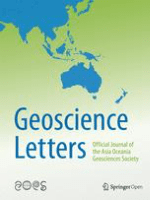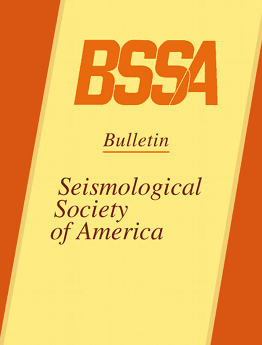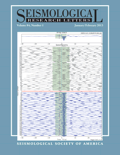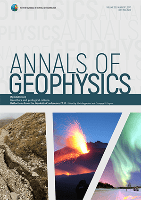
JOURNAL OF SEISMOLOGY
metrics 2024
Advancing seismic understanding through rigorous research.
Introduction
Welcome to the JOURNAL OF SEISMOLOGY, an esteemed publication in the field of Earth sciences, dedicated to the study of seismic phenomena and their implications on geophysical and geochemical processes. Published by SPRINGER and based in the Netherlands, this journal has been contributing to the academic community since 1997 and is set to continue through 2024. With an impressive ranking within the quartiles—Q2 in Geophysics and Q3 in Geochemistry and Petrology for 2023—this journal is a pivotal resource for researchers and professionals seeking to expand their understanding of seismic activities, earthquake mechanics, and related geological interactions. Despite not offering open access, it remains a highly regarded platform for disseminating rigorous research and findings in Earth and Planetary Sciences, sustaining a global readership keen on advancing their knowledge in this dynamic field. The JOURNAL OF SEISMOLOGY is committed to fostering scholarly exchange and advancing scientific inquiry, making it an invaluable asset for students, researchers, and professionals alike.
Metrics 2024
 0.48
0.48 1.60
1.60 1.60
1.60 65
65Metrics History
Rank 2024
Scopus
IF (Web Of Science)
JCI (Web Of Science)
Quartile History
Similar Journals

Earthquake Engineering and Engineering Vibration
Exploring the dynamics of vibration for a safer tomorrow.Earthquake Engineering and Engineering Vibration, published by Springer, is a leading international journal dedicated to the field of earthquake engineering, structural dynamics, and the associated vibrational research integral to understanding and mitigating seismic risks. With its print ISSN 1671-3664 and E-ISSN 1993-503X, the journal operates from its headquarters in New York, USA. The journal has achieved a commendable Q2 category ranking across multiple engineering disciplines, reflecting its importance to the building and construction, civil and structural engineering, geophysics, geotechnical engineering, and mechanical engineering fields. The journal serves as a vital platform for researchers, practitioners, and students to disseminate their findings, share innovative methodologies, and contribute to advancements in earthquake resilience and engineering practices. Earthquake Engineering and Engineering Vibration is committed to fostering open dialogue and collaboration within the global research community, ensuring that its contributions are both impactful and relevant to contemporary challenges in engineering and environmental safety.

Geoscience Letters
Unlocking the Secrets of Our PlanetGeoscience Letters, published by Springer, is a prominent open-access journal in the field of Earth and Planetary Sciences, recognized for its dedication to advancing knowledge and research in this vital area of study. With a reported impact factor that reflects its esteemed position—ranking in the Q1 quartile of Earth and Planetary Sciences, particularly as the journal ranks #48 out of 195 in the general category according to Scopus—the journal serves as a vital resource for researchers, professionals, and students. Since its inception in 2014, Geoscience Letters has facilitated the dissemination of high-quality research and critical insights, aiming to bridge the gap between scientific discovery and societal needs. Its commitment to open access ensures that the latest findings are readily available to a global audience, thus enhancing collaboration and innovation within the geosciences community.

Journal of Asian Earth Sciences-X
Bridging Regional Insights with Global PerspectivesJournal of Asian Earth Sciences-X, a distinguished publication by ELSEVIER, is at the forefront of Earth and planetary sciences, particularly focusing on the dynamic fields of geology and earth-surface processes. As an Open Access journal since 2019, it provides unparalleled access to high-quality research, fostering global collaboration and dissemination of knowledge. With an impressive impact factor and ranking in the Q2 category for both Earth-Surface Processes and Geology, it serves as a crucial platform for researchers, professionals, and students alike to share their findings and insights. Situated in the United Kingdom, the journal thrives on contributions that enhance our understanding of Asian geosciences within a broader global context, aiming to tackle major challenges such as climate change and natural resource management. By bridging regional studies with global perspectives, the Journal of Asian Earth Sciences-X is not only a vital resource for academia but also supports sustainable development initiatives across the region.

CHINESE JOURNAL OF GEOPHYSICS-CHINESE EDITION
Pioneering Research in Solid-Earth SciencesCHINESE JOURNAL OF GEOPHYSICS-CHINESE EDITION, published by SCIENCE PRESS, stands as a prominent platform for the dissemination of cutting-edge research in the fields of Geophysics and Geochemistry. Since its inception in 1979, this esteemed journal has successfully converged a wealth of knowledge, boasting a substantial impact factor and a recognized standing within the academic community, evidenced by its Q2 categorization in both Geochemistry and Petrology and Geophysics as of 2023. Researchers, professionals, and students looking to stay abreast of the latest advancements in solid-earth sciences will find the journal's comprehensive articles and studies invaluable. Based in Beijing, China, the journal emphasizes a broad scope, encompassing various aspects of geophysical research and methodologies. Although it does not currently offer open access options, its commitment to quality research makes it a crucial resource for the scientific community.

Journal of Volcanology and Seismology
Unraveling Earth's Secrets Through ResearchThe Journal of Volcanology and Seismology, published by PLEIADES PUBLISHING INC, serves as a pivotal platform for disseminating innovative research in the fields of volcanology and seismology. With an ISSN of 0742-0463 and an E-ISSN of 1819-7108, this journal aims to contribute to the understanding of geological processes, providing insights that are essential for both academic inquiry and practical applications in hazard management and environmental conservation. The journal spans from 2007 to 2024 and holds a respectable position in the academic community, classified within the Q3 quartile across key categories including Geochemistry and Petrology, Geology, and Geophysics. Despite the absence of an open access model, the journal remains highly relevant, ranking in the 34th Percentile for Geology and the 33rd Percentile for Geophysics, reflecting its commitment to quality and rigor. Researchers, professionals, and students are encouraged to engage with this resource to enhance their understanding and contribute original findings to the ever-evolving disciplines of Earth sciences.

Bulletin of the Mineral Research and Exploration
Championing Open Access for Geological DiscoveriesBulletin of the Mineral Research and Exploration, published by MADEN TETKIK VE ARAMA GENEL MUDURLUGU-MTA in Turkey, is a prominent open-access journal that has been disseminating vital research in the fields of geology and geotechnical engineering since 1936. With an ISSN of 0026-4563 and a commitment to sharing knowledge without barriers, this journal fosters an inclusive environment for researchers, professionals, and students alike. The journal is recognized for its contribution to the scientific community, illustrated by its Q3 ranking in Geology and Q4 ranking in Geotechnical Engineering and Engineering Geology for the year 2023. Despite its solid performance, the journal remains dedicated to improving its Scopus rankings, currently positioned at #230 out of 321 in Earth and Planetary Sciences for Geology, and #169 out of 229 in Geotechnical Engineering. The journal's historical convergence of years emphasizes its longstanding relevance and adaptability in disseminating cutting-edge research. By offering open access, it ensures that vital geological and engineering insights are readily available to a global audience, thereby enhancing collaboration and advancing knowledge in these crucial fields.

Geofisica Internacional
Exploring Innovative Solutions for Energy SustainabilityGeofisica Internacional, an esteemed academic journal published by the Instituto de Geofísica at UNAM, Mexico's prestigious National Autonomous University, has been a pivotal platform for advancing the field of geophysics and energy studies since its inception in 1975. This Open Access journal aims to disseminate high-quality research findings, making significant contributions to our understanding of Earth's processes and energy resources. With a current impact factor that situates it in the Q3 category for both Energy (miscellaneous) and Geophysics, it provides a continuous dialogue for researchers, professionals, and students interested in the intersection of these critical areas. Based in Mexico City and publishing articles that span various geophysical disciplines, Geofisica Internacional is indispensable for anyone seeking to stay at the forefront of environmental and energy research.

BULLETIN OF THE SEISMOLOGICAL SOCIETY OF AMERICA
Advancing seismic knowledge for a safer tomorrow.BULLETIN OF THE SEISMOLOGICAL SOCIETY OF AMERICA is a premier journal published by the Seismological Society of America, dedicated to advancing research in the field of seismology and related disciplines. Since its inception in 1969, this journal has garnered significant recognition, evidenced by its impressive Q1 category rankings in both Geochemistry and Petrology, and Geophysics, alongside a solid standing within the Earth and Planetary Sciences Scopus rankings. The journal is esteemed for publishing high-quality, peer-reviewed articles that contribute to the understanding of seismic activities and their implications on a global scale. With a commitment to facilitating the dissemination of critical findings, it serves as an essential resource for researchers, professionals, and students alike who are engaged in the dynamic and vital study of the Earth’s processes. While the journal is not Open Access, it continues to provide vital insights and methodologies that shape the future of geophysical research.

SEISMOLOGICAL RESEARCH LETTERS
Fostering a deeper understanding of our planet’s movements.SEISMOLOGICAL RESEARCH LETTERS is a leading journal in the field of geophysics, published by the Seismological Society of America. With its ISSN 0895-0695 and E-ISSN 1938-2057, this prestigious publication serves as a vital platform for disseminating groundbreaking research and advancements in seismological science. The journal boasts an impressive Q1 categorization in the 2023 rankings and ranks 23rd out of 165 in Earth and Planetary Sciences, Geophysics, placing it within the 86th percentile among its peers. Spanning an illustrious history from its origination in 1984 to its ongoing contributions through 2024, it is dedicated to fostering a deeper understanding of seismic phenomena. Although it currently does not offer open access, researchers, professionals, and students can benefit from timely insights and comprehensive studies presented in its pages. Set within the heart of the United States, the journal stands as a cornerstone in geophysics, connecting a global community eager to advance their knowledge and impact in the field.

ANNALS OF GEOPHYSICS
Pioneering Insights into Earth and Planetary SciencesANNALS OF GEOPHYSICS is a prestigious open access journal dedicated to the advancement and dissemination of research in the field of geophysics. Published by the IST NAZIONALE DI GEOFISICA E VULCANOLOGIA in Italy, this journal has embraced open access since its inception in 1948, promoting wide accessibility to cutting-edge research. With an impressive Scopus ranking, placing it in the 52nd percentile within Earth and Planetary Sciences for the category of Geophysics, the journal serves as a vital platform for scholars, researchers, and practitioners seeking to explore the intricate phenomena of our planet. Covering a diverse range of topics in the geophysical community, the ANNALS OF GEOPHYSICS invites contributions that push the boundaries of our knowledge and understanding of geophysical processes, aiding in the development of innovative solutions to urgent environmental challenges. Published continuously from 2002 to 2024, the journal’s commitment to quality and rigor is reflected in its Q3 quartile ranking for 2023, making it a notable resource for the academic community.